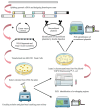Optimizing Yeast Homologous Recombination for Splicing Large Coronavirus Genome Fragments
- PMID: 39769503
- PMCID: PMC11677428
- DOI: 10.3390/ijms252413742
Optimizing Yeast Homologous Recombination for Splicing Large Coronavirus Genome Fragments
Abstract
Reverse genetics is a useful tool for studying viruses and developing vaccines for coronaviruses. However, constructing and manipulating the coronavirus genome in Escherichia coli can be time-consuming and challenging due to its large size and instability. Homologous recombination, a genetic manipulation mechanism found in organisms, is essential for DNA repair, gene recombination, and genetic engineering. In yeast, particularly Saccharomyces cerevisiae, homologous recombination technology is commonly used for constructing gene expression plasmids and genome editing. In this study, we successfully split and spliced a 30 kb viral genome fragment using yeast homologous recombination. By optimizing the program parameters, such as homologous arm lengths and fragment-to-vector ratios, we achieved a splicing efficiency of up to 97.9%. The optimal parameters selected were a 60 bp homologous sequence size and a vector fragment ratio of 1:2:2:2:2:2 for yeast homologous recombination of large DNA fragments.
Keywords: DNA assembly; automated splicing; reverse genetics; synthetic biology; yeast homologous recombination.
Conflict of interest statement
The authors declare no conflicts of interest.
Figures



Similar articles
-
A yeast-based reverse genetics system to generate HCoV-OC43 reporter viruses encoding an eighth subgenomic RNA.J Virol. 2025 Feb 25;99(2):e0167124. doi: 10.1128/jvi.01671-24. Epub 2025 Jan 30. J Virol. 2025. PMID: 39882907 Free PMC article.
-
A versatile, efficient strategy for assembly of multi-fragment expression vectors in Saccharomyces cerevisiae using 60 bp synthetic recombination sequences.Microb Cell Fact. 2013 May 10;12:47. doi: 10.1186/1475-2859-12-47. Microb Cell Fact. 2013. PMID: 23663359 Free PMC article.
-
Assembly of long DNA sequences using a new synthetic Escherichia coli-yeast shuttle vector.Virol Sin. 2016 Apr;31(2):160-7. doi: 10.1007/s12250-016-3730-8. Epub 2016 Apr 11. Virol Sin. 2016. PMID: 27113243 Free PMC article.
-
High molecular weight DNA assembly in vivo for synthetic biology applications.Crit Rev Biotechnol. 2017 May;37(3):277-286. doi: 10.3109/07388551.2016.1141394. Epub 2016 Feb 10. Crit Rev Biotechnol. 2017. PMID: 26863154 Review.
-
Efficient assembly of a synthetic attenuated SARS-CoV-2 genome in Saccharomyces cerevisiae using multi-copy yeast vectors.J Genet. 2024;103:09. J Genet. 2024. PMID: 38379228 Review.
References
MeSH terms
LinkOut - more resources
Full Text Sources

